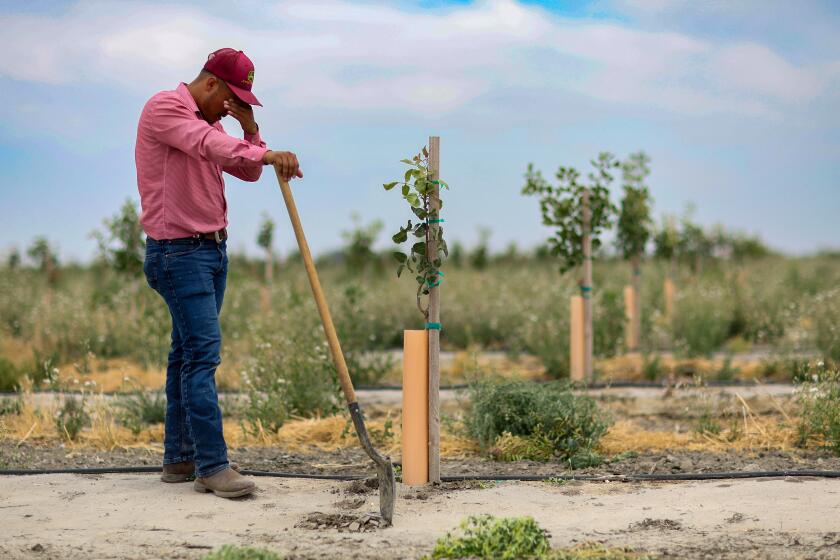STRUCTURES : Sweet History : Oxnard owes its birth to a sprawling turn-of-the-century sugar beet factory, which is highlighted in a museum exhibit.
“This is a golden opportunity to secure by far the biggest and most important enterprise that has ever been offered to Ventura County, and dull indeed will be our citizens if all the conditions are not promptly and cheerfully complied with.”
So read the fair Ventura readers of the Free Press late in 1897. The source of such excitement? Beets. Sugar beets by the ton, which were to serve as seeds for a new era in the developing territory near the Santa Clara River outside Ventura. Sugar kingpin Henry T. Oxnard had made an offer to build a $2-million sugar factory with a capacity to process 2,000 tons of beets daily. In exchange, local farmers were to dedicate 20,000 acres to beets over five years.
Almost a hundred years hence, Oxnard owes its birth to sugar, although sugar stopped being a viable crop there decades ago. In the beginning it was a beet boom town. Between its opening in 1899 and its closing in 1959, the factory sent out close to 40 million 100-pound bags of granulated sugar.
Oxnard has long dealt with jokes and sneers about its name, shrugging off joking references to bovine anatomy. In fact, the name refers to the brothers Oxnard, for whom sugar was in the blood. Robert, Benjamin, Henry T. and James Oxnard were the offspring of French-born 19th-Century sugar magnate Thomas Oxnard.
In 1860, the Oxnard brothers moved out West and started a beet factory in Chino. Henry T. Oxnard became interested in Ventura County through the promotions of Ventura farmer Albert F. Maulhardt, who had shown him that locally grown beets could yield better-than-average sugar content. Oxnard had originally wanted to place his factory in the small port community of Hueneme, but he met with resistance. He moved the location inland, to where the industrial area next to the “five points” intersection now sits.
On Aug. 19, 1899, a few months shy of the turn of the century, the sprawling American Sugar Beet Co. factory opened. James Driffill managed the factory and acted as a go-between for the interests of the factory and the growing community. (He later became Oxnard’s mayor and is now immortalized by Driffill Boulevard, running along the old factory site.)
The factory’s magnificent hum of activity and its magnetic force had an immediate effect on the still fairly barren area. Citizens of the nearby, smaller outposts of New Jerusalem and Port Hueneme literally packed their bags and their domiciles, moving hearths and homes toward this new beacon of produce, progress and gainful employment.
Soon, Oxnard’s operation was one of the largest sugar producers in the country, and the factory was the nucleus of what grew into the city of Oxnard--so named on June 30, 1903.
Legend has it that the city’s name was a bit of a fluke. While having lived there for only a few months (none of the other Oxnards ever called Oxnard home), the all-powerful Henry T. Oxnard had wanted to dub “his” town Sakchar--the Greek word for sugar. But a bad phone connection to the Sacramento office where the name was to be documented led to confusion, and he settled on his surname. Let us now praise bad phone lines: Oxnard, at least, is easier to pronounce than Sakchar.
Oxnard is the focus of the current exhibition at the Ventura County Museum of Art and History. Titled “Beans, Beets and Babies: Highlights in Oxnard’s History” and curated by Meg Beach, it chronicles the area’s past by featuring artworks, vintage photographs and artifacts of agricultural and cultural life in early Oxnard.
In the exhibit, painter Ruth Newman’s watercolor image of the almighty beet factory is aglow with admiration for this edifice. Cutting a heroic figure across the blue sky, it looks like a symbol of fertility and progress. Nearby on the gallery wall is Jack Miller’s painting of Old China Alley, a less noble scene. The ramshackle area where Chinese workers lived and congregated became notorious as a center of vice--saloons, prostitution, gambling and opium dens--and it was eventually bulldozed.
Along with a thriving beet factory came problems. On March 23, 1903, dissatisfied immigrant workers were involved in a skirmish resulting in gunfire with local lawmen that left one worker, Louis Vasquez, dead. Vasquez could be considered a martyr of sorts. In what is a small footnote in the history of labor, a short-lived union was created by and for Mexican and Japanese workers.
Despite its auspicious beginning, the factory’s glory days were numbered. By the time Henry T. Oxnard died in 1922, the factory’s success was tapering off. Causes of the factory’s slow demise have been attributed to the destructive encroachment of the whitefly, the increase of available irrigation water--enabling farmers to grow lemons and oranges--and new farmers inexperienced in the growing of sugar beets.
Diversification of crops, including lima beans and grain, allowed the factory to stay afloat. After years of faltering production and stiffening competition from imported sugar, the Oxnard factory closed on Oct. 26, 1959.
You can still see a remnant of the old beet citadel, in all its squared-off, stoic brick splendor, on Factory Lane off Wooley Road. The GE Plastics division now makes its home there. In Oxnard, sugar begat plastics as one of her crops of choice. Time marches on.
More to Read
Sign up for Essential California
The most important California stories and recommendations in your inbox every morning.
You may occasionally receive promotional content from the Los Angeles Times.






